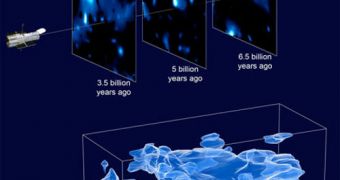For decades, astronomers and astrophysicists have been looking at methods of detecting dark matter, the stuff believed to make up about a quarter of the Universe. Its existence was hypothesized a long time ago, but no practical experiments were able to show it exists. This has frustrated many experts, while others began saying that the theory may be wrong, and that new directions of research should be followed. Now, a group of scientists is taking the quest for dark matter to the lab, where they plan to analyze materials that behave similarly to stuff, in a bid to find out more, Space reports.
What is all the more frustrating is that no one really knows what kind of particles make up dark matter. Some say that elementary particles known as axions could be some of the components. These fragments of matter have no electrical charge, and only a small mass. Generally, the international physics community accepts that the particles in dark matter do not interact with light (photons), or with other forms of regular matter, which is why normal detection methods would never function.
Just recently, it has been revealed, however, that the mathematical equations which underline the existence of axions are also very similar to the ones on which topological insulators are based. These are materials whose exterior are able to conduct electrons, and therefore electricity, but whose interiors do not allow for electricity to pass through. “That both are described by the same mathematical equation is the beauty of physics. Mathematics is so powerful – it means we can study these things in topological insulators as if they were a baby universe,” says Stanford Institute for Materials and Energy Science (SIMES) condensed matter theorist Shoucheng Zhang.
“If we 'see' an axion in a tabletop experiment, it will be extremely illuminating. It will help shed light on the dark matter mystery,” he adds. Doing so would take some of the strain off existing detectors, which are constructed deep underground. They contain massive spheres filled with various liquids, that are supposed to show when an unknown particle passes through. These large machines are covered with various layers of insulators, so as to isolate it from stray radiation of other kinds. Moving the hunt on tabletops could make everyone's lives a lot easier.

 14 DAY TRIAL //
14 DAY TRIAL //